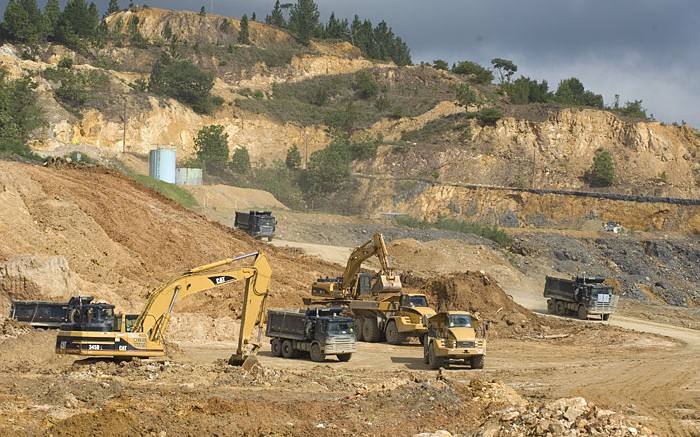VANCOUVER — After putting four years and $3.7 billion into developing a massive gold mine that is expected to produce 1 million oz. gold annually during the first five years of its 25-year lifespan, it’s little surprise that the majors behind Pueblo Viejo are willing to do whatever it takes to ensure their mine operates smoothly — even if that means giving the government of the Dominican Republic an extra $1.5 billion.
The mine is run by Pueblo Viejo Dominicana Corporation (PVDC), a joint venture between 60%-owner Barrick Gold (ABX-T, ABX-N) and partner Goldcorp (G-T, GG-N). The two brought Pueblo Viejo, one of the largest gold mines in the world, online in January.
Within weeks, the government of the Dominican Republic demanded a bigger piece of the profits.
Its motives are understandable. For one, the government and PVDC hammered out the mine’s Special Lease Agreement (SLA) in 2009, when gold was worth just US$800 per oz. Over the next few years the price of the yellow metal doubled, before dropping to its current level near US$1,480 per oz.
The government also says the original deal is simply too generous. Dominican President Danilo Medina said the deal gave the people of the Dominican Republic just $3 for every $100 in mine profits, a ratio that was “simply unacceptable.”
As such, few were surprised when Medina demanded a redo on the operating contract. And it was no empty threat: he said he would impose a windfall tax on profits if PVDC was not willing to talk.
After a few months of talking, PVDC and the Dominican government have reached an agreement in principle on how to move forward as friends and partners. The parties have agreed to increase revenues to the government and move up the start date for those monies. Under the old deal, most payments to the government were delayed until PVDC had recouped its construction costs.
The agreement lists four possible mechanisms by which to achieve these goals, which includes eliminating a 10% return before the onset of a 28.75% net profit tax, extending the period during which the miners recover their capital investment, a delay in applying for tax deductions and reducing depreciation rates.
PVDC and the government will now sit down and determine which of these mechanisms they will use to bring forward and increase tax payments. The new deal will also incorporate a graduated minimum tax that will track metal prices and reset every three years by mutual agreement.
Barrick says the new deal will aim to split Pueblo Viejo’s cash flows between PVDC and the Dominican government from 2013 until 2016. Assuming a gold price of US$1,600 per oz., this should provide the Dominican government with US$2.2 billion over the three-year period. This near-term cash is a marked departure from the old agreement, under which the Dominican government would not have received initial payments from the most significant mine tax — the 28.75% net profit tax — until roughly 2019, when PVDC has recouped its capital investment, plus a 10% return.
In the long-term, Barrick estimates the new deal will give the government another $1.5 billion, based on US$1,600 per oz. gold. That is on top of the roughly US$10 billion it was already expecting over Pueblo Viejo’s 25-year mine life.
Other important parameters within the SLA are expected to remain largely unchanged, including a 25% corporate tax rate, a 3.2% net smelter return royalty and a 28.75% net profits tax.
Once PVDC and the Dominican government settle on the SLA amendments they will sign a definitive agreement that will require approval from the Barrick and Goldcorp’s boards of directors, the project lenders and the Congress of the Dominican Republic.
For its part, on announcing the agreement in principle the Dominican government reiterated its commitment to facilitating the timely granting of the permits needed to continue operations at the mine.
Analysts responded to the news with mixed feelings. On the plus side, renegotiating the SLA removes the overhang of political uncertainty, which is significant, because the threat of a battle between mine operators and a host government creates a nebulous shadow over any company’s share price.
On the downside, whatever the eventual details, the new deal will inevitably take benefits away from Barrick and Goldcorp shareholders. Greg Barnes of TD Securities calculated that the changes would reduce Barrick’s net cash flow per share by US19¢ in 2013 and US41¢ in 2014. For Goldcorp, Barnes forecasts a net cash flow decrease of US23¢ per share this year and US51¢ next year.
Given the need to find common ground, however, the general consensus from analysts was that the deal was just fine.
“Assuming that a definitive deal is completed, we expect that reaching a deal with the DR government should lift uncertainty and improve sentiment towards Barrick,” Barnes wrote.
News of the deal came out an hour before the markets closed on May 8. Barrick shares fell 44¢ to $21.06, while Goldcorp shares dropped 36¢ to close at $30.03.


Be the first to comment on "Pueblo Viejo partners to give DR gov’t more money, and sooner"